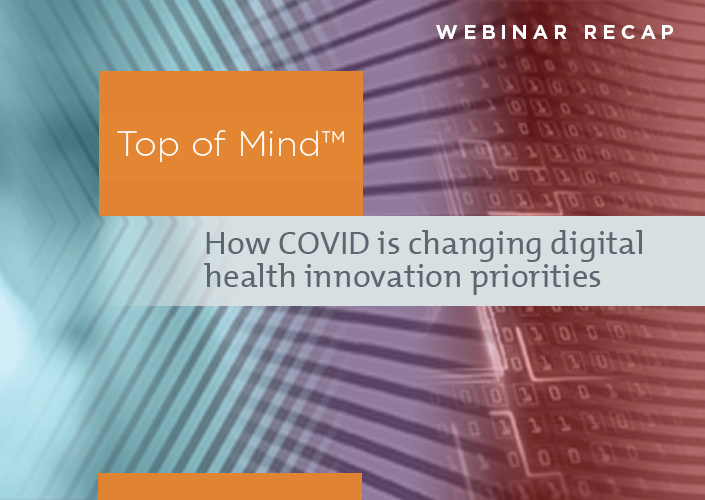Health system experts weigh in on “what’s next” for digital health; on-demand webinar now available
There’s no doubt the COVID-19 pandemic accelerated digital health at many health systems.
Most health systems were successful in meeting skyrocketing demand for telemedicine visits and other virtual care at the height of the pandemic. But leaders are now asking, “What’s next?”
Leading health systems are focused on providing a better virtual experience, using digital health technology to keep patients engaged between visits, and harnessing data, analytics, and advanced tools to fully leverage the power of digital health.
“Many of these health systems had a three-year strategy that was achieved in three weeks,” Adam Gale, President of KLAS Research, said during a Center for Connected Medicine (CCM) webinar about innovation priorities at health systems for the year to come.
“I’ve asked several executives, look, if you’ve hit that telehealth strategy that you had much more quickly than you expected, what happens next? They said, we can’t just replicate what we’ve done before,” said Gale, who moderated the webinar, “Top of Mind: How COVID Is Changing Digital Health Innovation Priorities,” and explained health system leaders are considering how virtual visits may be different than in-person visits.
The webinar, which is now available on-demand, featured expert panelists from Brigham & Women’s Hospital, Indiana University Health, and UPMC discussing key findings from the CCM’s Top of Mind for Top Health Systems research report.
Conducted in partnership with KLAS, the research examines the impact of COVID-19 on innovation priorities at health systems and dives into three key technologies for the future: telehealth, artificial intelligence, and revenue cycle management.
The webinar panelists were:
- Emily C. Webber, MD, Chief Medical Information Officer, Indiana University Health and Riley Children’s Health
- Mark Zhang, DO, Medical Director, Digital Innovation Hub, Brigham & Women’s Hospital
- Oscar Marroquin, MD, Chief Healthcare Data and Analytics Officer, UPMC
Digital health can reduce fragmentation of care
Health care delivery has been criticized for being episodic and fragmented. But digital health gives providers the opportunity to stay connected to their patients outside of hospital or clinic.
Dr. Webber cited an example from IU Health on efforts to reduce fragmentation: a home monitoring system that sent a daily text to check-in was widely deployed during the pandemic.
“Now, we are all really thinking about how we engage with the patient outside of the doors of our clinics and hospitals,” Dr. Webber said.
Dr. Webber made the point that this technology was already available and in use prior to COVID-19, but only in use among a small subset of providers and patients. Now, “it’s started to become part of the expectation,” she said.
For the future, health systems can build on this momentum by continuing to innovate with existing technology. “I don’t see complicated technology steps. I see integrating simple technologies but in innovative ways,” she said.
We won’t Excel our way out
Building on Dr. Webber’s point about episodic care, Dr. Marroquin provided an example from UPMC, which is using analytics and other solutions to better manage patient care across populations and connect with individual patients who are due for screening, tests, and procedures.
These solutions go well beyond simply handing a provider or clinic an Excel spreadsheet list of their patients who missed an appointment or are due for a mammogram. These tools need to be integrated with telemedicine solutions, the patient portal, and other systems.
“We’re not going to Excel our way out of this, right? Meaning, providing Excel spreadsheets to the different clinical groups is not going to be the way,” Dr. Marroquin said.
Dr. Marroquin and his team have created self-service solutions that allow clinicians to get an overview of their populations and then dive into a view of all patients who have canceled appointments and have chronic conditions, for example.
“Now it has become embedded within the operations to allow us to do things more efficiently,” he said.
Data must be part of the digital strategy
The explosion of digital health has created a huge volume of new data that should be incorporated into a health system’s strategy.
“Being able to represent the data, interpret it, and react to the data we’re generating is an incredibly important aspect of our strategy,” Dr. Zhang said. “We’re finding unique ways to utilize the data we’re generating and that has also been incredible to see.”
Understanding these new data streams from digital health can lead to unexpected insights. For example, Dr. Zhang described a daily symptom attestation tool for employees that was implemented during the pandemic at Brigham & Women’s Hospital.
The system not only allowed the hospital to assess how many employees might be sick and unable to work, but Dr. Zhang said it also was used to provide what turned out to be a highly accurate representation of how many employees were on premises at any given time. “We used that to extrapolate how many pieces of PPE to order for each site,” he said.
“It’s been really interesting to see how we can begin to make almost real-time, informed decisions based on what we’re seeing from the signal from these interventions,” he said.
More topics covered by webinar panelists
In addition to digital health innovation strategy and priorities for the future, the hour-long webinar examined several other topics. Led by Gale, the panelists covered telehealth experience for patients and providers; data measurement and value of telehealth; AI solutions implemented in response to COVID; and much more.
Learn more about the CCM’s Top of Mind program
The CCM’s Top of Mind program focuses on telehealth, artificial intelligence and revenue cycle management through a research report, virtual roundtables, and a virtual summit. Learn more about the full program.



